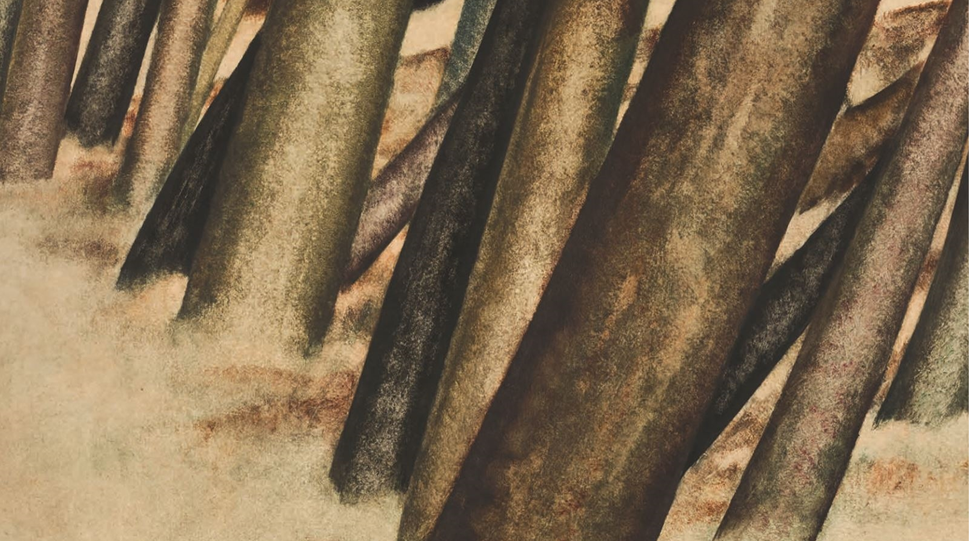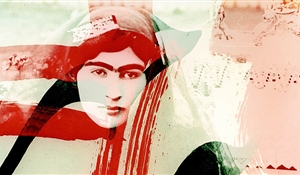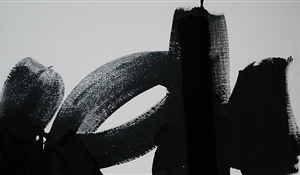A Note on Sohrab Sepehri's "Trees"
12 Jul 2022"I saw that the tree exists.
When there is a tree, no doubt I should live.
I should live to trace the narrative to the white lines."
Sohrab Sepehri started the "Trees" series at the beginning of the 1970s. Depicting a dream that had remained out of his reach became his refuge from the urban life. Sepehri had a deep attachment to the topography of his homeland, Kashan. In 1972, when he had to stay longer than expected in New York, he used his homesick feelings to create a new series. During one of these days, he wrote to his old friend, Ahmadreza Ahmadi: "I'm stuck in a city that has no birds and trees." This may be when the "Trees" series came to his mind for the first time.
The "Trees" series or "I am close to the beginning of the earth. I know the water's fate and the tree's green habit."

Sohrab Sepehri | Untitled | Tree | 1967 | oil on canvas | 155 × 100 cm
Sepehri knew nature for its generosity and reputation. He was inspired by what he had perceived of Eastern traditions when he traveled to India and Japan. He considered nature a guide for those lost in urban life; a natural, flawless world that presents order, harmony, and simplicity, but is removed from the chaotic urban atmosphere. But why a tree? In the "Trees," Sepehri has focused on the most notable resident of nature; the tree. The tree is an eternal integral entity full of life. It is a final example of nature's force and symbolic focal point. The tree has all four elements of life: soil in its roots; water in its twigs; oxygen that emits for the earth's residents; and fire for which it acts as fuel. This may be why it has attracted Sepehri's attention.
From another viewpoint, choosing the tree is based on Sepehri's faith in concise beauty. The Zen tradition, which he practiced daily, disapproves of wordy descriptions and demands summarizing and omitting excessive elements of a narrative. This is why he only draws trunks. He was not a realist. To draw a landscape, a tree is enough; from that tree, its essence is necessary. This is why he pays attention to the meaning of the tree and its aesthetic nature rather than its physical existence in a landscape. As Morteza Momayez has once said:
"Simplicity is the most notable feature of Sepehri's works. Simplicity in terms of naivety, modesty, and plainness of themes, avoiding subjects, words, forms, and issues that are uselessly complicated and unnecessarily intimidate the viewer. "
Based on such an attitude, he used a very limited range of colors in a palette consisting of greys and dark greens. Limiting the colors is a conscious practice for brevity, reflecting the official constraints of Zen's haikus and Sepehri's belief that using colors minimally leads to more artistic transparency. The limited color palette has not prevented the artist from successfully and faithfully depicting the texture, complications, and color changes between the trees.

Depicting the tree was, for Sepehri, an act of meditation that accorded with "Hitsuzendō" Japanese tradition; an attempt to creatively and concisely reflect the self. Hitsuzendō refers to a school of Japanese Zen calligraphy that does not comply in any way with the rating system of modern calligraphy. Instead of emphasizing order, Hitsuzendō is related to the artist's inner experience of passion that originates from the unification of the artist and the environment. Unlike the Western traditions in which the artist consciously uses their technical skills to create an artwork, Zen painting tradition considers "the human, art, and work" all to be the same, and what is created by the artist is actually the manifestation of this unification. Sepehri's acquaintance with the Japanese Zen tradition dates back to an internship course in printing that he attended in Tokyo. When he applied to the Academie des Béaux-Arts in Paris in 1957, he had visited Italy, Africa, and India, and now it was time to visit Japan. In 1970 he signed up for a printing course in Tokyo, and there he became acquainted with Japanese philosophy, culture, and poetry that later influenced his painting and poems significantly. Morteza Momayez truthfully said:
"When you look at Sepehri's paintings, you are actually reading his poems, but in a different language; the visual language."
"I am full of light and sand
And full of trees
I am full of roads, bridges, rivers, waves
I am full of the shadow of a leaf inside the water"
Like his paintings, Sepehri's poems indicate a unity between him and his surroundings, a coexistence of him and nature. What we can understand from the "Trees" series is simplicity, affection for nature, and becoming united with it. According to his friend and companion, Karim Emami, this is what Sepehri's life looked like.
Sources:
-
https://www.bonhams.com/auctions/26226/lot/40/
-
https://www.bonhams.com/auctions/25460/lot/25/
-
https://www.bonhams.com/auctions/25461/lot/22/
-
Emami, Karim. "From The Song Of Poppy To Beyond: A Review of Sohrab Sepehri's Painting and Poetry", Iran Nameh, Winter 1986, Vol. 18, p. 341.
-
Anoushiravani, Alireza & Atashi, Laleh. "A Comparative and Interdisciplinary Study of Poetry and Painting in Sohrab Sepehri's Work".






